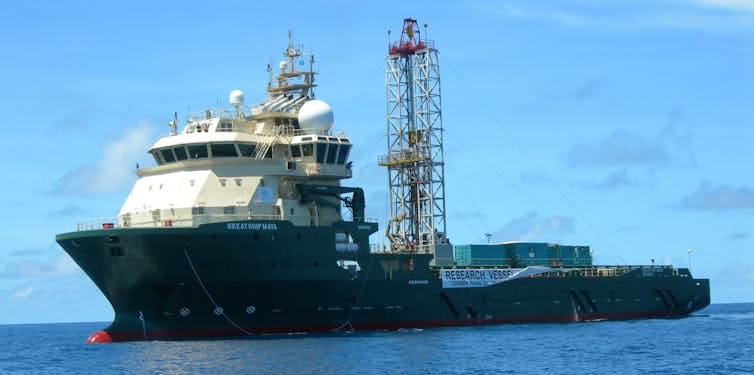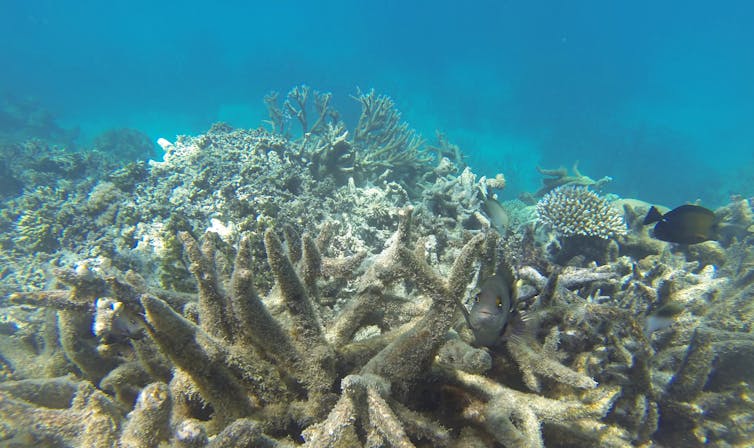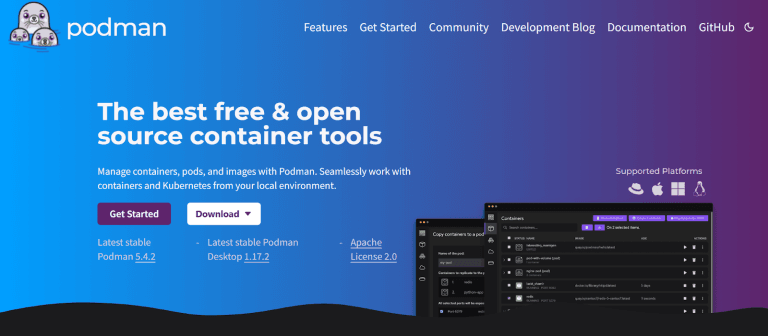In the 20th century, global sea level rose faster than at any other time in the past 3,000 years. It’s expected to rise even further by 2100, as human-induced climate change intensifies. In fact, some studies predict a rise of up to 1.6 metres and possibly more due to the rapid melting of the Antarctic ice sheets.
These changes will have huge impacts on coastal ecosystems around the world, including coral reefs. To understand these future impacts, it can be useful to understand similar events from history.
Our new research, published today in Nature Communications, does just that. It reveals how the Great Barrier Reef in northern Australia responded to a dramatic rise in sea level some 13,000 to 10,000 years ago.
A hotly debated event
Several “meltwater pulse events” have been documented in the past. These occur when ice sheets disintegrate in a catastrophic fashion, resulting in a rapid surge in global sea levels.
One of these events, known as “meltwater pulse 1B”, remains hotly debated. It occurred roughly 11,500 years ago.
Early evidence from reef cores in Barbados suggested a sharp sea-level rise of approximately 14 metres between 11,450 and 11,100 years ago, with rates of roughly 40 millimetres per year.
Remarkably, this rate is about ten times faster than the current global rise.
However, this record conflicts with others, including from Tahiti and now from the Great Barrier Reef, which suggests a more gradual rise in sea levels.
Learning from geological archives
Somewhat paradoxically shallow-water reef systems can “drown” because corals, and other reef organisms, depend on light for photosynthesis. If the water gets too deep too fast, the reef will no longer keep up with the rise and it will drown.
But drowning can also occur due to other factors, such as increased temperature, sediment and nutrients, which can also add extra environmental stress to the reef – again making it more difficult to grow vertically and keep up with sea level rise.
Cores gathered from drowned fossil coral reefs preserved along the continental shelf edge of the Great Barrier Reef contain crucial information about historic corals, coralline algae and microbial reef structures known as microbialites. They offer a unique geologic time machine to better understand how past periods of rapid global sea level rise affected reef growth.
These geological archives also provide important clues about how ice sheets behaved in response to rapid global warming.
In 2010, an expedition of the Integrated Ocean Drilling Program used a geotechnical drill ship to sample below the seafloor and reconstruct the growth and demise of the Great Barrier Reef over the past roughly 30,000 years. Five distinct stages were identified in response to major global climatic and oceanographic disturbances.
In this new study, we focused on a key reef stage called Reef 4. It formed between 13,000 and 10,000 years ago, just prior to the start of the modern reef as we know it.
We refer to this reef as the “proto-Great Barrier Reef”. Once a shallow-water barrier reef system, it now exists in a fossilised form at roughly 50 metres water depth and is now the home to deeper reef communtites in the mesophotic zone 30 to 150 metres below the surface.

G.Tulloch/European Consortium for Ocean Research Drilling/Integrated Ocean Drilling Program
An impressive ability to keep pace
Our study shows the Great Barrier Reef didn’t drown during meltwater pulse 1B. In fact, it continued to thrive with clear evidence of healthy, shallow-water reef assemblages (living in waters less than ten metres deep) persisting right through the rise in sea levels.
The reef not only survived but continued to grow upwards at rates between 4–6 millimetres per year. This rate of growth is comparable to modern healthy reef growth rates, demonstrating an impressive ability to keep pace.
We also calculated that the maximum possible sea-level rise during meltwater pulse 1B was between 7.7 and 10.2 metres over roughly 350 years. This equates to between 23 and 30 millimetres per year, but was likely less.
This is less than the Barbados estimate, and more consistent with observations from Tahiti where no sharp sea-level jump was found.
Importantly, this indicates that even the upper sea level rise bounds are within the survival limits of resilient reef systems such as the Great Barrier Reef – especially when environmental stressors, such as ocean warming, ocean acidification and sedimentation are low.

Darkydoors/Shutterstock
Limits to a reef’s resilience
Although the Great Barrier Reef survived sea level rise roughly 11,000 years ago, the world was very different back then.
Coral reefs faced less stress from human impacts. And ocean temperatures were rising more slowly.
But today’s reefs are already struggling, with UNESCO’s World Heritage Committee recently expressing “utmost concern” about the state of the Great Barrier Reef in particular.
This is due to warming, acidification and pollution. And these additional challenges decrease reefs’ ability to cope with rapid sea-level rise.
Our findings suggest abrupt sea-level jumps of more than 11 metres are unlikely to occur without major instabilities in ice sheets. The fact that such collapses likely didn’t happen during meltwater pulse 1B offers some reassurance. But we’re in uncharted territory now, particularly with the Antarctic ice sheet displaying early signs of instability.
Our study also shows the Great Barrier Reef has been remarkably resilient, adapting to changing sea levels and continuing to grow even as the ocean rose rapidly. This resilience, however, had limits. Ultimately, the reef we examined drowned roughly 10,000 years ago, likely due to a combination of environmental stressors, including increased sediment flux. At this time the shallow water reef ecosystem migrated landward to form the modern Great Barrier, leaving behind only deeper, mesophotic reef communities.
The lessons from the past are clear: reefs can adapt to environmental changes but there are limits.
Protecting modern reefs will require more than understanding their past. It means reducing emissions and limiting other environmental stresses such as sediment and nutrient runoff where possible.





